
Beaufortia is a genus of woody shrubs and small trees in the family Myrtaceae and is endemic to Southwest Australia. The genus Beaufortia is closely related to Melaleuca, Calothamnus, Regelia and several others, differing mainly in the way the anthers are attached to the stalks of the stamens, and in the way they open to release their pollen. Beaufortia anthers are attached at one end and open by splitting at the other.
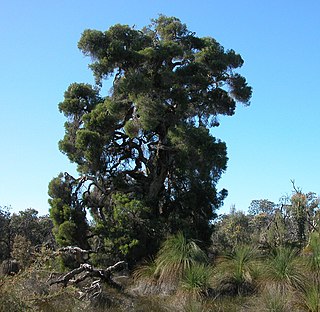
Melaleuca preissiana, commonly known as stout paperbark, modong or moonah, is a plant in the myrtle family, Myrtaceae and is endemic to coastal areas of southwest Australia. It is a shrub or small tree with papery bark, small leaves and spikes of usually white flowers. It occurs chiefly in areas that are seasonally wet.

Regelia is a genus of flowering plants in the family Myrtaceae and is endemic to the south-west of Western Australia. The genus is composed of five species of small leaved, evergreen shrubs which have heads of flowers on the ends of branches which continue to grow after flowering. Another species, previously known as Regelia punicea and which is endemic to Kakadu National Park in the Northern Territory, has been transferred to Melaleuca punicea.
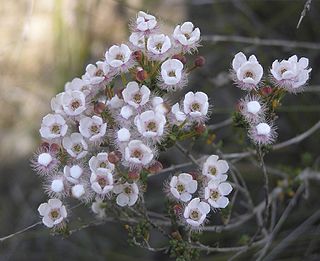
Verticordia habrantha, commonly known as hidden featherflower, is a flowering plant in the myrtle family, Myrtaceae and is endemic to the south-west of Western Australia. It is a slender shrub with short, leafy side-branches and long flowering stems with rounded heads of mostly white flowers. Its hairy sepals are mostly hidden by the round, unfringed petals, and as a result, the plant looks like shrubs in the genus Chamelaucium, to which it is closely related.

Regelia velutina, the Barrens regelia, is a species of flowering plant in the myrtle family Myrtaceae. It is endemic to the south-west of Western Australia. It is a large shrub with greyish green, velvety leaves and large clusters of brilliant red to orange flowers on the ends of its branches in spring and summer.

Melaleuca aspalathoides is a small shrub in the myrtle family, Myrtaceae and is endemic to a small area in the south-west of Western Australia. It is a small shrub with soft, grey foliage and distinctive calyx lobes around each of its magenta-coloured flowers.
Melaleuca manglesii is a plant in the myrtle family Myrtaceae and is endemic to a small area in the south-west of Western Australia. It is a low, spreading shrub which produces large numbers of heads of purple flowers with yellow tips in spring.
Calothamnus lehmannii, commonly known as dwarf claw flower, is a plant in the myrtle family, Myrtaceae and is endemic to the south-west of Western Australia. It is a low-lying, sometimes ground-hugging shrub with long, thin, cylindrical leaves and clusters of red flowers that are smaller than any others in the genus Calothamnus.

Beaufortia anisandra, commonly known as dark beaufortia, is a plant in the myrtle family Myrtaceae, and is endemic to the southwest of Western Australia. It is a densely branched shrub with egg-shaped, upward pointing leaves and which bears heads of dark bluish-purple to red flowers with stamen bundles of different lengths. It is reported to have an unpleasant odour.

Beaufortia elegans, commonly known as elegant beaufortia, is a species of flowering plant in the myrtle family, Myrtaceae and is endemic to the southwest of Western Australia. It is an erect, diffuse shrub with crowded, curved leaves and heads of flowers that are usually reddish purple, although other colours also occur.

Beaufortia empetrifolia, commonly known as south coast beaufortia, is a plant in the myrtle family, Myrtaceae and is endemic to the southwest of Western Australia. It is a highly branched shrub with small, crowded leaves and pinkish to purple flowers in small, bottlebrush-like spikes in the warmer months. It is similar to Beaufortia micrantha except that its leaves are slightly larger.

Beaufortia micrantha, commonly known as small-leaved beaufortia or little bottlebrush, is a species of flowering plant in the myrtle family, Myrtaceae and is endemic to the southwest of Western Australia. It is a compact shrub with tiny leaves pressed against the stems and profuse heads of purple or pinkish-coloured flowers.

Beaufortia schaueri, commonly known as pink bottlebrush or pink beaufortia, is a species of flowering plant in the myrtle family, Myrtaceae and is endemic to the southwest of Western Australia. It is a small, rounded shrub with small, crowded, linear leaves and profuse, spherical heads of pink flowers conspicuously displayed on the ends of the branches in spring.
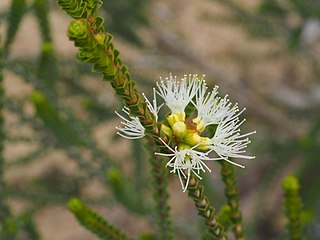
Beaufortia sprengelioides is a species of flowering plant in the myrtle family, Myrtaceae and is endemic to the southwest of Western Australia. It is a rigid, spreading shrub with crowded, round leaves and small, roughly spherical heads of pale pink flowers on the ends of its branches. It was one of the first Australian plant species collected by Europeans and has had several name changes since then.

Beaufortia squarrosa, commonly known as sand bottlebrush, is a species of flowering plant in the myrtle family, Myrtaceae and is endemic to the southwest of Western Australia. The Noongar peoples know the plant as buno. It is sometimes a dense shrub, others straggling with 4 neat rows of small, oval leaves along the stems, and heads of red, orange or yellow flowers in the warmer months.
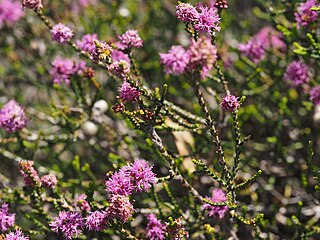
Regelia cymbifolia is a plant in the myrtle family, Myrtaceae and is endemic to the south-west of Western Australia. It is a much branched shrub bearing tiny, wedge shaped leaves and clusters of deep pink to purple flowers on the ends of its branches in spring.
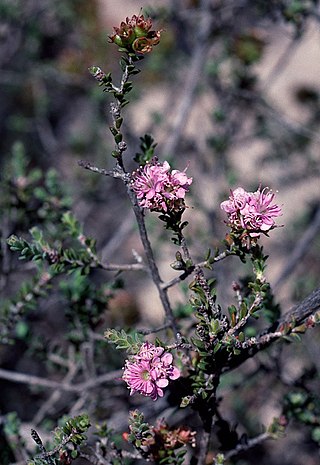
Kunzea micromera is a flowering plant in the myrtle family, Myrtaceae and is endemic to the south west of Western Australia. It is a small, sparse shrub, similar in some respects to K. micrantha but has shorter, more rounded sepal lobes. It produces groups of pink flowers on the ends of a few long shoots in spring.

Kunzea pauciflora, the Mount Melville kunzea, is a species of flowering plant in the myrtle family Myrtaceae, and is endemic to a small area on the south coast of Western Australia. It is a shrub with the stems densely branched near their ends, linear leaves and one, two or three pink flowers near the ends of the branches but usually only at the top of the shrub.

Kunzea praestans is a flowering plant in the myrtle family, Myrtaceae and is endemic to Western Australia. It is an erect shrub with sessile leaves and groups of about fourteen to twenty pink flowers in more or less spherical groups on the end of the branches.
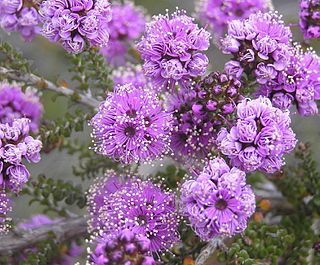
Kunzea recurva is a flowering plant in the myrtle family, Myrtaceae and is endemic to Western Australia. It is an uncommon shrub with small leaves and groups of pink or purplish flowers on the ends of the branches.



















